When HubSpot surveyed a handful of business leaders within our customer base, we discovered that most expect to see "somewhat slower" or "much slower" growth in the next year as a result of the global pandemic and economic climate.
Data from our more-than 70,000 global customer base supports business slowdown predictions. In the first few weeks of the crisis, we saw that while sales outreach has increased, response rates and deal volume dropped to new lows. Although sales email engagement has rebounded greatly to new highs in recent days, the large and noticeable dip demonstrates the uncertainty and evolving metrics that brands are seeing right now.
Both Sales and Marketing metrics seem to be changing rapidly. For example, overall, HubSpot researchers found that the ratio of marketing email engagements to open rates has improved since around the start of the crisis. However, this rate did see its own dips in early April, as seen in the chart below,
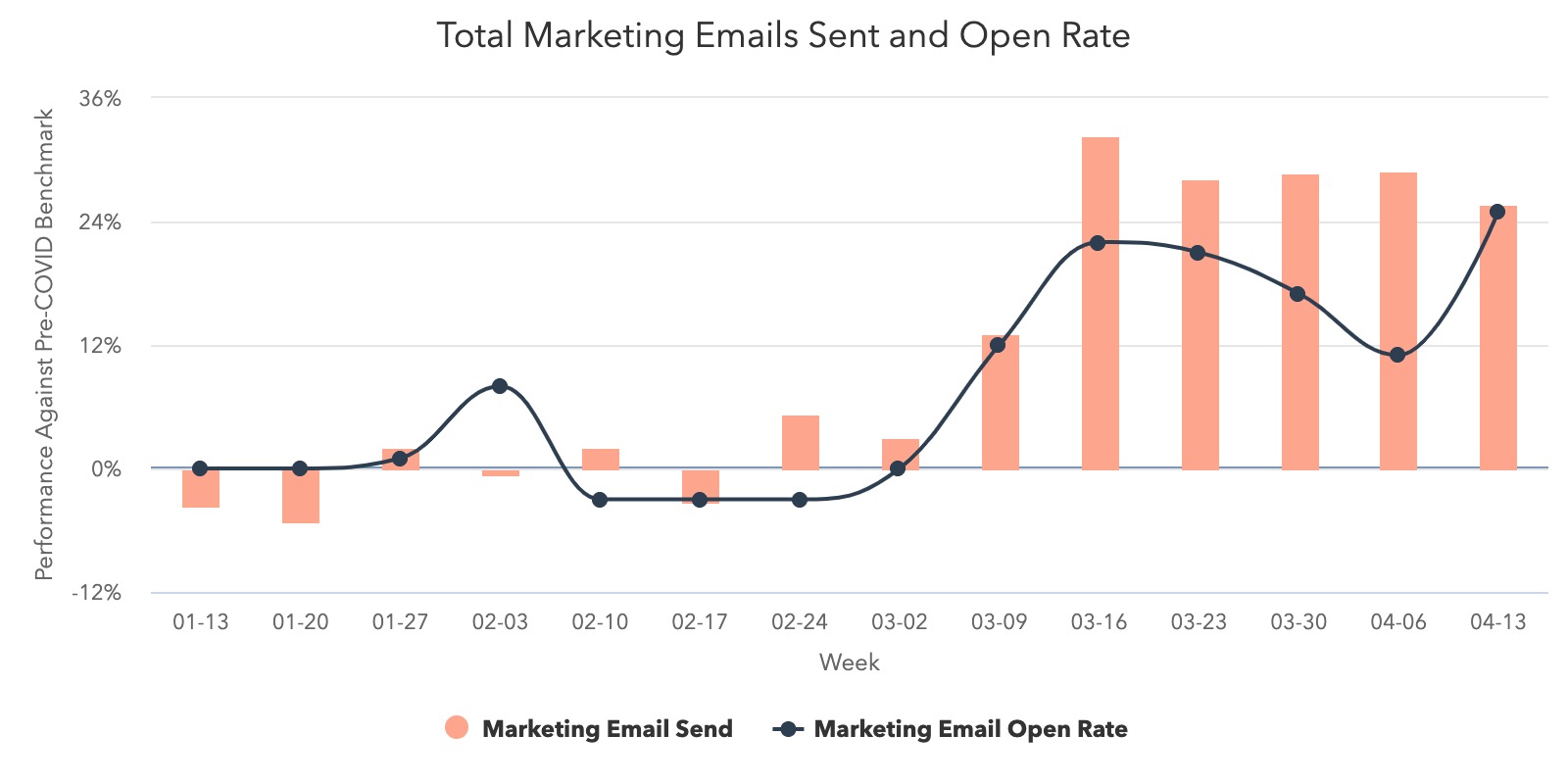 Our data also revealed that customers are researching brands more heavily online and initiating more online interactions with businesses today than they were a year ago. Between February and March, this online behavior resulted in average monthly website traffic increasing by 13%. This interest in researching online brands might also be fueling an increase in customer-initiated conversations with sales reps.
Our data also revealed that customers are researching brands more heavily online and initiating more online interactions with businesses today than they were a year ago. Between February and March, this online behavior resulted in average monthly website traffic increasing by 13%. This interest in researching online brands might also be fueling an increase in customer-initiated conversations with sales reps.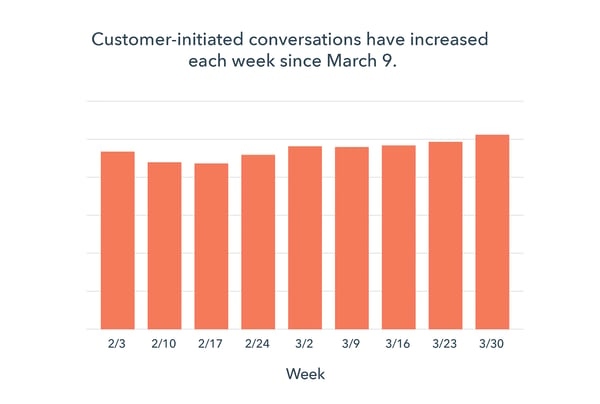
For a timeline of benchmark data updates and changes, click here to keep up with our latest findings.
With constantly changing benchmark data and the future economic landscape in mind, business leaders, including HubSpot customers, are trying to determine what changes they'll need to make in the next year and beyond.
Here are four ways that our own customers are pivoting their brand's offerings, budgets, and strategies in light of COVID-19.
4 Pivots Companies Are Making in 2020
1. Companies are cutting down on non-essential costs.
When we spoke with HubSpot customers, most said they plan to cut down or deprioritize non-essential aspects of their business. With many non-essential processes being paused, many companies are leveraging budgets to cover customer retainment strategies and tactics that they know will still generate revenue.
"We've had to make a lot of budget shifts in light of COVID-19. We made a decision early on to decrease our monthly spend by 70%, which felt nearly impossible," shares Hope Horner, CEO of Lemonlight. "We went through every line item in our general ledger and marked each one as essential or non-essential. Then, we prioritized sales and marketing because they drive demand for the rest of the business."
"It hasn't been easy," Horner shares. "Overall, we remain optimistic about the plans we have in place, but without the ability to shoot new content, we're forced to be as cautious as possible. What's most important to us is that in 30 to 90 days when the dust settles, there's a place for everyone to return and resume work."
Aside from focusing on termed strategies, some businesses have also decided to move budget from physical in-person processes into digital or virtual tactics.
"We've been redeploying physical event spend, leaning more heavily into digital and account-based strategies," says SurveyMonkey CMO, Leela Srinivasan.
Meanwhile, those who haven't made cuts yet say they're "keeping an eye" on revenue and future budgets.
"We're grateful that so far, we haven't had to make significant cuts to our budget," says Gabriela Pereira, Founder of DIY MFA. "That said we are being more vigilant with our spending and we're scrutinizing our expenses even more carefully than before."
Pereira adds, "We're also making strategic decisions about where we invest our resources. We've realized that certain back-burner projects have become more relevant given current events, so we've shifted our resources to make these a priority."
Specifically, some of the common line items that business leaders say they plan to cut or have already cut include non-essential hiring, processes that don't yield high ROI, physical events, field sales, and team support.
2. Marketers are budgeting immediate or long-term tactics.
Many HubSpot customers that we spoke to aren't focusing on marketing projects that might generate revenue or acquisition in an uncertain H2. Instead, these business leaders are either taking a short or long-term approach.
Particularly, many brands are focusing on online resources, social media tactics, email marketing, virtual events, or digital customer retainment strategies. Many companies have also adjusted their brand messaging to ensure that they are being thoughtful and not coming off as "tone deaf" to their audience.
"We have cut down on sales and marketing activities that yield short term results," says Matthew Pollard, CEO of Rapid Growth Coach LLC. "We have, however, doubled down on marketing and product development activities that will provide us an edge in the months after the lockdown period and the possible 18 months that will follow, which we see as the consensus for when things will return to normality."
While Pollard's company is focused on long-term strategies, other companies have chosen to invest in short-term marketing tactics
"Our marketing programs are short-term focused to maximize pipeline generation potential in the short term," says Bernie Borges, Co-Founder and CMO of Vengreso. "Everything is mapped out in 30, 60 and 90-day priorities."
Pivoting to or embracing digital strategies might be a solid choice at this time. According to our recently published benchmark data, web traffic and marketing email engagements of our customers have risen since the pandemic began.
To help marketers determine which digital strategies they should invest in right now, here's what a few of our customers say they're doing:
3 Tactics Marketers are Leveraging
Postponing or Virtualizing Events
Many companies that rely on events for valuable marketing and sales are looking at other opportunities. While some have decided to postpone major in-person events, some are leveraging video software and social media to run virtual events.
"Perhaps the biggest pivot is that we had planned to focus more on in-person events and programs this year," Pereira says. "We were about to announce the launch of our inaugural live event when the first shelter in place orders started happening. To that end, we decided to postpone the live event to 2021 and pivot back to virtual and online programs, an arena that we have already dominated for some time."
Pereira adds, "This is not to say that we are abandoning in-person programming altogether, but simply that we have shifted our timeline and we're doubling down on programs that are more in alignment with our audience's current needs."
Similarly, Sangram Vajre, Co-Founder of Terminus, explained that the brand's field events would be moving to either "LinkedIn Live or VIP Zoom meetings."
Creating Online Resources
Creating online content that's informative, resourceful, and responsive to current landscapes can be valuable to both current customers and potential prospects. Even if brands have shifted away from focusing on client acquisition to provide value to their current customers, new audiences might still see a company's current informational content and potentially research the brand.
In light of the pandemic and economic climate, many of the business leaders we surveyed noted that they're investing in or pivoting content to provide better value to customers at this time.
"The biggest shift for our marketing team was related to the content we were publishing and sharing. Overnight, nearly all of the content we had written became irrelevant or tone-deaf," says Horner. "We had to quickly rethink our overall messaging and position to adapt to the new landscape."
Rahul Raj, Founder and CMO of 5&Vine, explained that his team decided to invest in "more resources to support our content, social and community teams and less for strategy and digital acquisition."
Similarly, SurveyMonkey has also been producing educational resources for their customers and audiences.
"Yesterday, I ran a webinar with my CEO and Chief People Officer to help other organizations explore ways to stay connected to their workforce in a world where everyone is working from home," Srinivasan shares. "Before coronavirus hit, we already thought of this as the feedback economy, and world events have only made feedback more essential in running a modern business. We have a genuine desire to help."
Adjusting Marketing Messaging
By now, many business leaders have recognized that their customers need to make difficult decisions about budgets and which projects they'll invest in. Because of this, many of the HubSpot customers we surveyed are adjusting their brand's messaging to relate more to what their customers are going through right now.
"We're embracing moral leadership by acknowledging the world is different, people are hurting and ensuring we're being of service to our clients, their customers, and the front line workers helping to keep us safe and well," Raj says. "We're shifting our investment from advertising to empathy, philanthropy, facilitating community connection, and inspirational content."
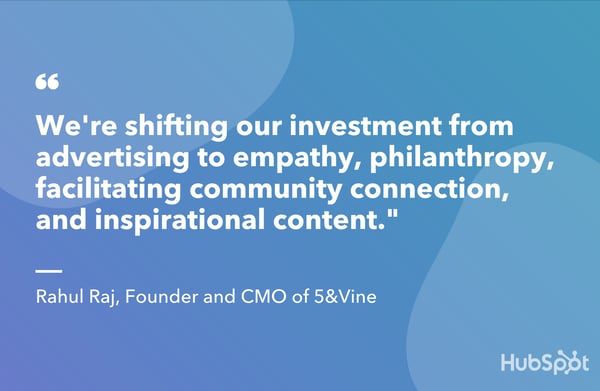
Meanwhile, Pereira explains, "In terms of our messaging, we've shifted focus to emphasize more of the WHY -- not just our own WHY as a business, but the bigger WHY for our audience."
"As a business that provides professional education programs and information products for writers, part of our job is to remind our audience that what they are doing matters," Pereira shares. "It's easy for writers to feel discouraged by current events, but stories matter. Art matters."
"Yes, we're all focused on survival right now -- and rightly so -- but books, stories, poetry, these are things that make us want to survive. Right now, part of our job at DIY MFA is to keep reminding writers that their work is important," Pereira concludes.
3. Companies are focusing on great experiences for current customers.
Aside from pivoting marketing tactics, the business leaders we spoke to are hyper-focused on improving the customer experience in order to retain the clients.
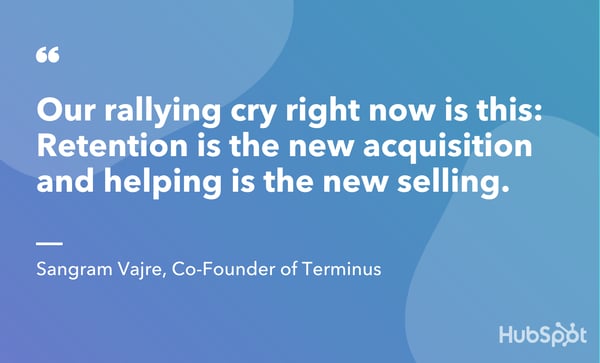
To boost the customer experience and adapt to the current landscape, those we spoke to are using tactics such as bringing company events online, discounted products or services, and investing in general customer experience improvements.
"We're tweaking some of our product priorities and building offerings that coalesce with solving for the business fallout in front of our customers," says Patrick Campbell, ProfitWell's Founder and CEO.
Campbell adds, "The positioning of our product from pure revenue growth or churn mitigation is shifting slightly to a more defensive posture to focus on helping businesses curtail losses and retain customers longer. We're being more nuanced in our targeting within the market at large."
How Businesses are Prioritizing Customer Experience
Discounted Products, Services, or Online Courses
As companies determine which services are too expensive for their budgets right now, some of our business leaders say their brands are offering discounts to lessen potential financial burdens and please their customers.
"Our revenue comes mostly from online programs and our team has always worked remotely, so in terms of our day-to-day operations and overall strategy, not much has changed," Pereira explains. "At the same time, we are also very aware that for many people in our audience circumstances have turned upside down and that they will likely have to cut back on their spending. We're shifting our focus to offer more options at lower price points to accommodate people's tighter budgets."
Adjusting or Creating Offerings to Help Impacted Customers or Prospects
Aside from offering discounts, some companies are also tweaking services or products they offer to be more valuable to clients impacted by the global pandemic.
"Our strategies reflect the ways in which we can add value in the current environment," says Srinivasan. "We're providing resources in the form of survey templates organizations can copy and deploy, regularly refreshed consumer sentiment research across several countries and discounts for educators and nonprofits."
"We're also reaching out to our enterprise customers more frequently, providing transparency and links to resources as well as finding out how we can support them," Srinivasan adds.
4. Brands are empathizing with clients who need solutions -- not pitches.
When it comes to marketing, sales, and service, HubSpot customers say their companies are trying to embrace empathy more than ever.
For example, sales or service reps might call clients to check in on how they're doing rather than upselling them.
In some cases, showing empathy could even involve choosing not to pursue a lead that might be struggling at this time.
"We had to be more thoughtful when we were reaching out to prospects and opportunities," Horner says. "We separated each industry and created an outline of the new challenges they might be facing and the solutions they might be looking for. In some industries, we quickly realized that we no longer offered solutions they need right now and we decided to send them a quick and thoughtful message but did not follow up on any sales opportunities."
Horner adds, "In other industries, we realized their needs have likely shifted so we repositioned our approach when reaching out to them. Most importantly, we opened up most of our conversations by acknowledging the current crisis."
Here's an example of an email that Horner's team might send to follow up with a customer or prospect at this time:
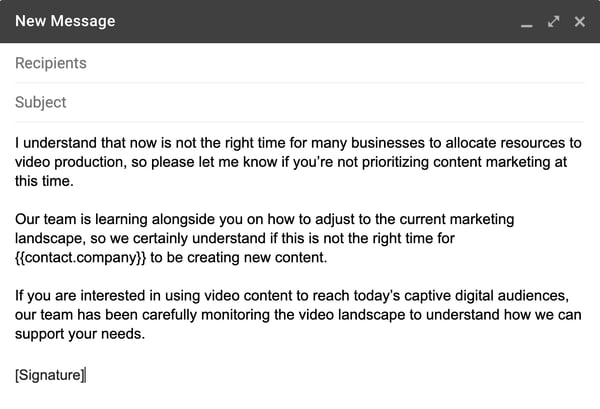
When it comes to empathizing with customers, Raj explains that "this is a time to be our best selves."
"Our families, neighbors, and customers need more from us," Raj says. "They don't need to be sold to, they need to be heard and supported."
"We're all in customer support. We're all in service to others. We always have been, but the world needs more from us now. They need us to put humanity above profitability." Raj concludes.
Navigating New Economic Landscapes
Overall, companies are spending less time and money on audience growth, while investing more in boosting the customer experience, providing value to their target audience, and empathizing with clients and prospects that might be making incredibly difficult decisions.
To help our own customers and audiences, we're creating and regularly updating a number of posts and resources -- including this piece -- to better inform businesses in this uncertain time.
For further information related to the global pandemic and its resulting economic landscape, here's a quick list of recently published blog posts and online resources:
Benchmark Data
- Adapt 2020: An Education Series
- Marketing and Sales Benchmark Data Timeline
- Edition 3 of HubSpot's Adapt Benchmarking Series
Resources for Small Businesses
- How Small Businesses Can Take Advantage of the U.S. Stimulus Package
- Where to Find Public and Private Small Business Funding in 2020
Disclaimer: This blog post is meant as a basic resource and not a comprehensive guide. We will regularly update it to add more information as it becomes available.
No comments:
Post a Comment